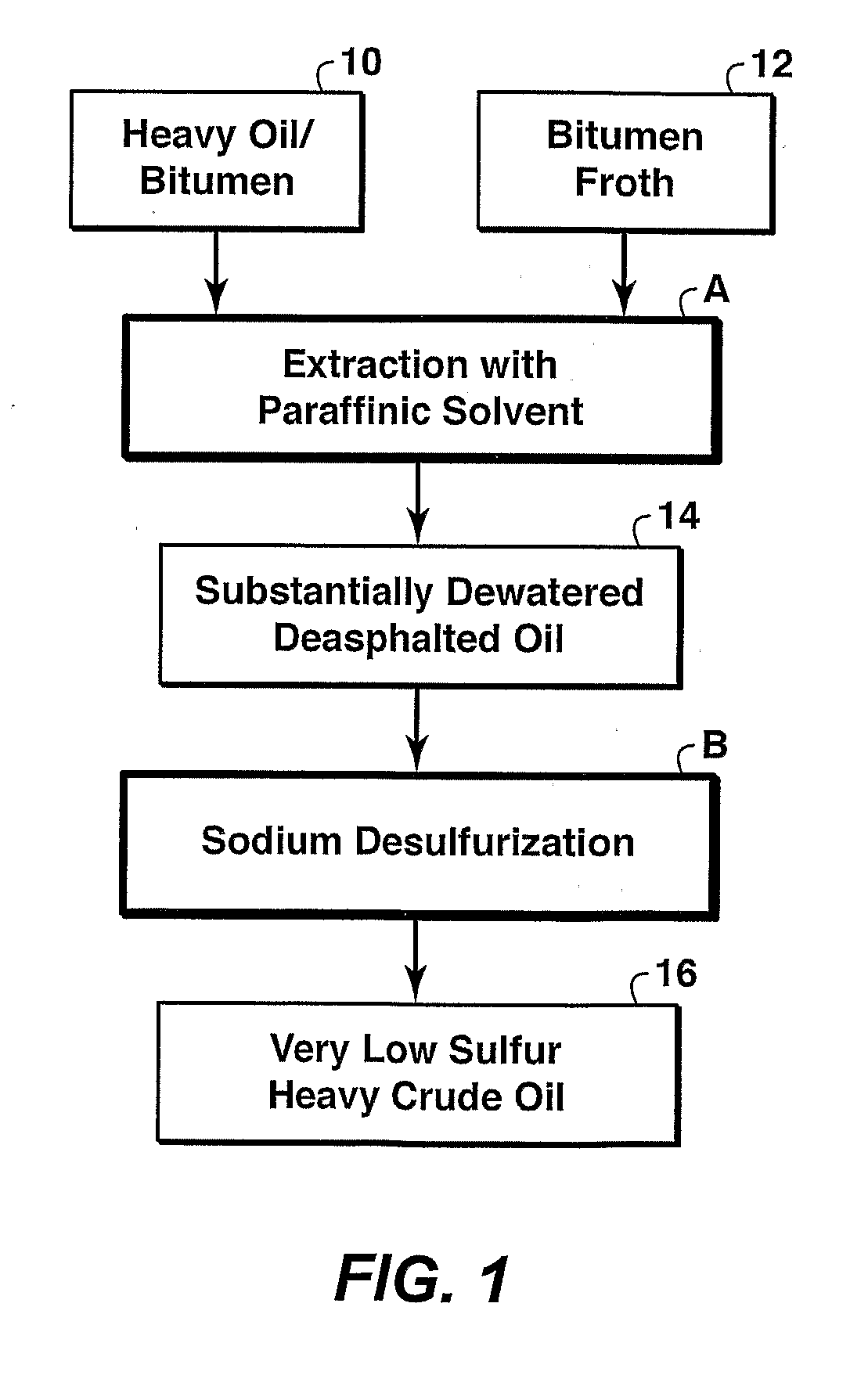Very Low Sulfur Heavy Crude oil and Porcess for the Production thereof
a crude oil and very low sulfur technology, applied in the field of very low sulfur heavy crude oil, can solve the problems of high api gravity, high yield loss, and high sulfur content, and achieve the effects of low sulfur content, low sulfur content, and low sulfur conten
- Summary
- Abstract
- Description
- Claims
- Application Information
AI Technical Summary
Benefits of technology
Problems solved by technology
Method used
Image
Examples
example 1
Asphaltene-Reduced Dewatered Oil from 8:1 Extraction of Bitumen with nC4
[0062]Bitumen obtained from Cold Lake, Alberta was extracted with nC4 (butane) solvent using a solvent to bitumen ratio of 8:1. The bitumen contained 4.84 weight % sulfur, 81.21 weight % carbon, and had an initial API gravity of about 10.1. The resulting asphaltene-reduced dewatered oil fraction represented 72.8 weight % of the starting weight of bitumen, while the remaining asphaltene fraction represented 27.2 weight % of the starting weight of bitumen. The deasphalted oil fraction contained 0.01 weight % water, and had an ash content of less than 0.2 weight %. The oil fraction contained 84.15 weight % carbon, 10.77 weight % hydrogen, and less than 0.5 weight % nitrogen. The sulfur content was reduced to 3.77 weight %. The API gravity of the resulting oil was 16.0° API. The asphaltene fraction contained 7.65 weight % sulfur. The deasphalted oil fraction derived from this example which has a reduced sulfur conte...
example 2
Asphaltene-Reduced Dewatered Oil from 4:1 Extraction of Bitumen with nC4
[0063]Bitumen obtained from Cold Lake, Alberta was extracted with nC4 (butane) solvent using a solvent to bitumen ratio of 4:1. The bitumen contained 4.84 weight % sulfur, 81.21 weight % carbon, and had an initial API gravity of about 10.1. The resulting asphaltene-reduced dewatered oil fraction represented 71.6 weight % of the starting weight of bitumen, while the remaining asphaltene fraction represented 28.4 weight % of the starting weight of bitumen. The deasphalted oil fraction contained <0.03 weight % water, and had an ash content of less than 0.21 weight %. The oil fraction contained 84.67 weight % carbon, 10.99 weight % hydrogen, and about 0.73 weight % nitrogen. The sulfur content was reduced to 3.56 weight %. The API gravity of the resulting oil was 15.9° API. The asphaltene fraction contained 7.66 weight % sulfur. The deasphalted oil fraction derived from this example which has a reduced sulfur conten...
example 3
Asphaltene-Reduced Dewatered Oil from Extraction of Bitumen with iC4
[0064]Bitumen obtained from Cold Lake, Alberta was extracted with iC4 (isobutane) solvent using a solvent to bitumen ratio of 8:1. The bitumen contained 4.84 weight % sulfur, 81.21 weight % carbon, and had an initial API gravity of about 10.1. The resulting asphaltene-reduced dewatered oil fraction represented 64.1 weight % of the starting weight of bitumen, while the remaining asphaltene fraction represented 35.9 weight % of the starting weight of bitumen. The deasphalted oil fraction contained <0.01 weight % water, and had an ash content of less than 0.18 weight %. The oil fraction contained 84.03 weight % carbon, 11.14 weight % hydrogen, and less than about 0.5 weight % nitrogen. The sulfur content was reduced to 3.42 weight %. The API gravity of the resulting oil was 17.8° API. The asphaltene fraction contained 7.00 weight % sulfur. The deasphalted oil fraction derived from this example which has a reduced sulfu...
PUM
 Login to View More
Login to View More Abstract
Description
Claims
Application Information
 Login to View More
Login to View More - R&D
- Intellectual Property
- Life Sciences
- Materials
- Tech Scout
- Unparalleled Data Quality
- Higher Quality Content
- 60% Fewer Hallucinations
Browse by: Latest US Patents, China's latest patents, Technical Efficacy Thesaurus, Application Domain, Technology Topic, Popular Technical Reports.
© 2025 PatSnap. All rights reserved.Legal|Privacy policy|Modern Slavery Act Transparency Statement|Sitemap|About US| Contact US: help@patsnap.com


